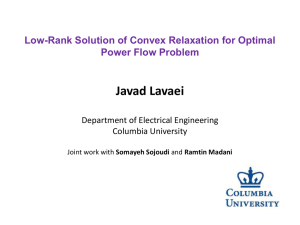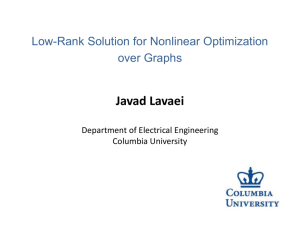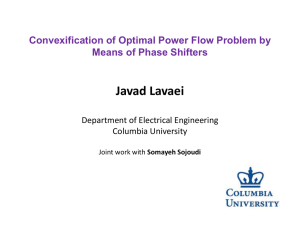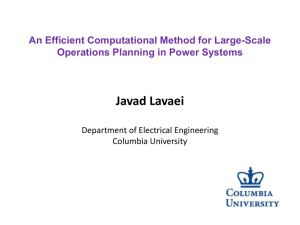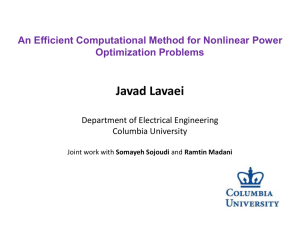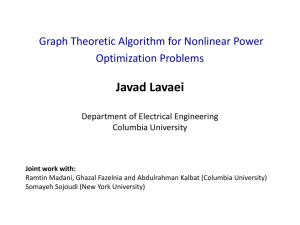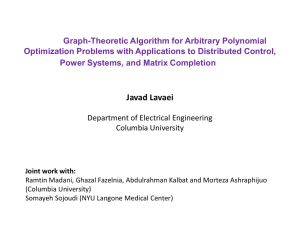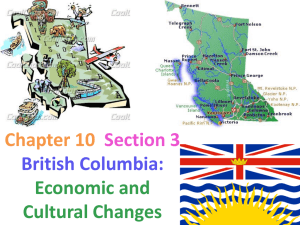Slides - Electrical Engineering
advertisement
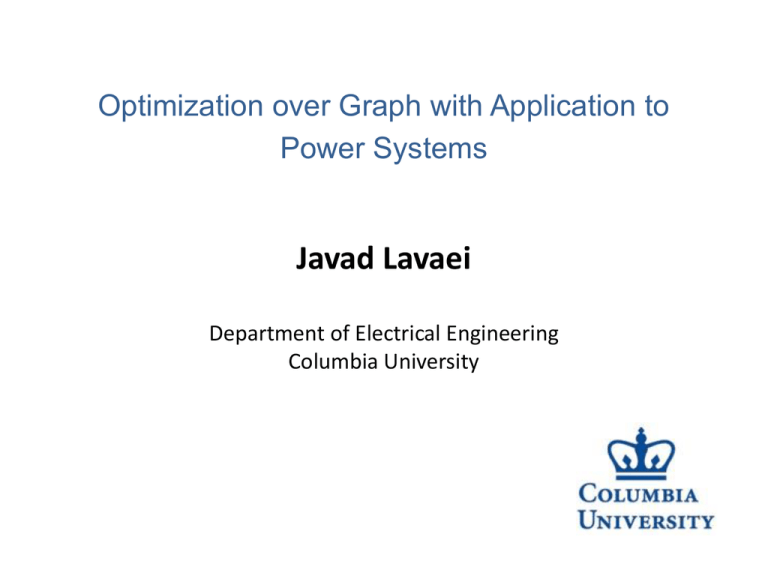
Optimization over Graph with Application to Power Systems Javad Lavaei Department of Electrical Engineering Columbia University Acknowledgements Caltech: Steven Low Somayeh Sojoudi Stanford University: Stephen Boyd Eric Chu Matt Kranning UC Berkeley: David Tse Baosen Zhang J. Lavaei and S. Low, "Zero Duality Gap in Optimal Power Flow Problem," IEEE Transactions on Power Systems, 2012. J. Lavaei, D. Tse and B. Zhang, "Geometry of Power Flows in Tree Networks,“ in IEEE Power & Energy Society General Meeting, 2012. S. Sojoudi and J. Lavaei, "Physics of Power Networks Makes Hard Optimization Problems Easy To Solve,“ in IEEE Power & Energy Society General Meeting, 2012. M. Kraning, E. Chu, J. Lavaei and S. Boyd, "Message Passing for Dynamic Network Energy Management," Submitted for publication, 2012. S. Sojoudi and J. Lavaei, "Semidefinite Relaxation for Nonlinear Optimization over Graphs with Application to Optimal Power Flow Problem," Working draft, 2012. S. Sojoudi and J. Lavaei, "Convexification of Generalized Network Flow Problem with Application to Optimal Power Flow," Working draft, 2012. Power Networks (CDC 10, Allerton 10, ACC 11, TPS 12, ACC 12, PGM 12) Optimizations: Resource allocation State estimation Scheduling Issue: Nonlinearities Transition from traditional grid to smart grid: More variables (10X) Time constraints (100X) Javad Lavaei, Columbia University 3 Resource Allocation: Optimal Power Flow (OPF) Voltage V Current I Complex power = VI*=P + Q i OPF: Given constant-power loads, find optimal P’s subject to: Demand constraints Constraints on V’s, P’s, and Q’s. Javad Lavaei, Columbia University 4 Broad Interest in Optimal Power Flow Interested companies: ISOs, TSOs, RTOs, Utilities, FERC OPF solved on different time scales: Electricity market Real-time operation Security assessment Transmission planning Existing methods based on local search algorithms Can save $$$ if solved efficiently Huge literature since 1962 by power, OR and Econ people Recent conference by Federal Energy Regulatory Commission about OPF Javad Lavaei, Columbia University 5 Summary of Results Project 1: How to solve a given OPF in polynomial time? (joint work with Steven Low) A sufficient condition to globally solve OPF: Numerous randomly generated systems IEEE systems with 14, 30, 57, 118, 300 buses European grid Various theories: It holds widely in practice Project 2: Find network topologies over which optimization is easy? (joint work with Somayeh Sojoudi, David Tse and Baosen Zhang) Distribution networks are fine. Every transmission network can be turned into a good one. Javad Lavaei, Columbia University 6 Summary of Results Project 3: How to design a parallel algorithm for solving OPF? (joint work with Stephen Boyd, Eric Chu and Matt Kranning) A practical (infinitely) parallelizable algorithm It solves 10,000-bus OPF in 0.85 seconds on a single core machine. Project 4: How to relate the polynomial-time solvability of an optimization to its structural properties? (joint work with Somayeh Sojoudi) Project 5: How to solve generalized network flow (CS problem)? (joint work with Somayeh Sojoudi) Javad Lavaei, Columbia University 7 Problem of Interest Abstract optimizations are NP-hard in the worst case. Real-world optimizations are highly structured: Sparsity: Non-trivial structure: Question: How does the physical structure affect tractability of an optimization? Javad Lavaei, Columbia University 8 Example 1 Trick: SDP relaxation: Guaranteed rank-1 solution! Javad Lavaei, Columbia University 9 Example 1 Opt: Sufficient condition for exactness: Sign definite sets. What if the condition is not satisfied? Rank-2 W (but hidden) NP-hard Javad Lavaei, Columbia University 10 Example 2 Opt: Acyclic Graph Real-valued case: Rank-2 W (need regularization) Complex-valued case: Real coefficients: Exact SDP Imaginary coefficients: Exact SDP General case: Need sign definite sets Javad Lavaei, Columbia University 11 Sign Definite Set Real-valued case: “T “ is sign definite if its elements are all negative or all positive. Complex-valued case: “T “ is sign definite if T and –T are separable in R2: Javad Lavaei, Columbia University 12 Formal Definition: Optimization over Graph Optimization of interest: (real or complex) Define: SDP relaxation for y and z (replace xx* with W) . f (y , z) is increasing in z (no convexity assumption). Generalized weighted graph: weight set Javad Lavaei, Columbia University for edge (i,j). 13 Real-Valued Optimization Edge Cycle Javad Lavaei, Columbia University 14 Complex-Valued Optimization Main requirement in complex case: Sign definite weight sets Generalization of Bose et al. work from Caltech SDP relaxation for acyclic graphs: real coefficients 1-2 element sets (power grid: ~10 elements) Javad Lavaei, Columbia University 17 Complex-Valued Optimization Purely imaginary weights (lossless power grid): Generalization of Zhang & Tse’s work from UC Berkeley Consider a real matrix M: Polynomial-time solvable for weakly-cyclic bipartite graphs. Javad Lavaei, Columbia University 18 Optimal Power Flow Cost Operation Flow Balance Express the last constraint as an inequality. Javad Lavaei, Columbia University 19 Exact Convex Relaxation OPF: DC or AC Networks: Distribution or transmission Result 1: Exact relaxation for DC/AC distribution and DC transmission. Energy-related optimization: Javad JavadLavaei, Lavaei,Columbia Stanford University University 17 20 Exact Convex Relaxation Each weight set has about 10 elements. Due to passivity, they are all in the left-half plane. Coefficients: Modes of a stable system. Weight sets are sign definite. Javad JavadLavaei, Lavaei,Columbia Stanford University University 17 21 Exact Convex Relaxation AC transmission network manipulation: High performance (lower generation cost) Easy optimization Easy market Javad JavadLavaei, Lavaei,Columbia Stanford University University PS 17 22 Injection Regions Injection region for acyclic networks: When can we allow equality constraints? Need to study Pareto front Javad Lavaei, Columbia University 23 Generalized Network Flow (GNF) injections flows limits Goal: Assumption: • fi(pi): convex and increasing • fij(pij): convex and decreasing Javad Lavaei, Columbia University 24 Convexification of GNF Feasible set without box constraint: Convexification: It finds correct injection vector but not necessarily correct flow vector. Javad Lavaei, Columbia University 25 Convexification of GNF Feasible set without box constraint: Correct injections in the feasible case. Why decreasing flow functions? Javad Lavaei, Columbia University 26 Conclusions Motivation: OPF with a 50-year history Goal: Develop theory of optimization over graph Mapped the structure of an optimization into a generalized weighted graph Obtained various classes of polynomial-time solvable optimizations Talked about Generalized Network Flow Passivity in power systems made optimizations easier Javad Lavaei, Columbia University 27
